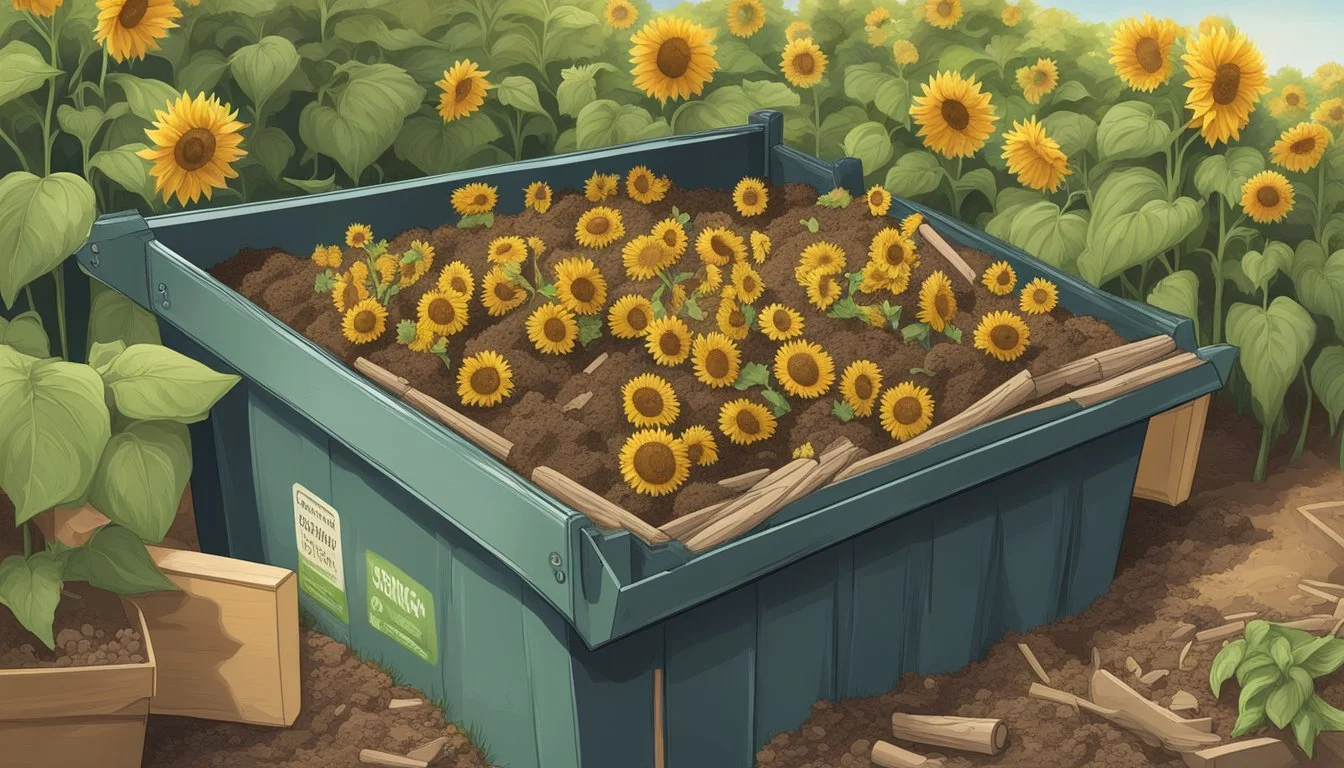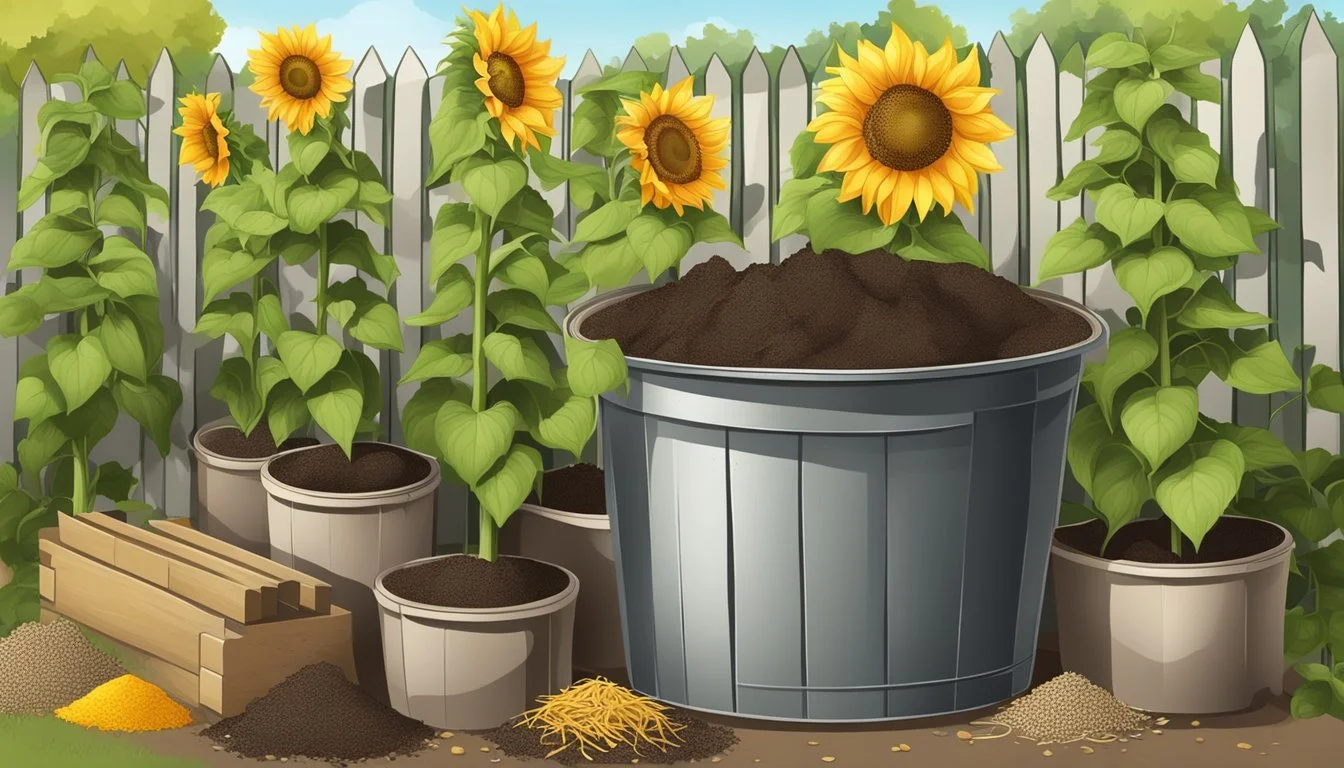Can You Compost Sunflower Stalks?
A Guide to Recycling Garden Waste
Sunflower stalks, with their sturdy structure and fibrous material, might seem like a challenge to dispose of after the bloom has passed. However, they are indeed compostable. Composting is a natural process that breaks down organic materials into a rich soil amendment known as compost. Sunflowers, being organic matter, can contribute to this cycle, turning garden waste into a beneficial resource for future planting.
When adding sunflower stalks to a compost pile, it's beneficial to break them down into smaller pieces to accelerate decomposition. Their robust nature means they take longer to break down than softer plant materials, so cutting or crushing them can help. The stalks can serve an additional role in composting; they can provide aeration to the pile, which is crucial for the microbial activity necessary for successful composting.
Care should be taken not to overload the compost pile with too many sunflower stalks at once, as their density and slow degradation could lead to an imbalance in the composting process. Intermixing them with a variety of other green and brown materials helps create a balanced and nutrient-rich compost ideal for enriching garden soil.
The Importance of Composting in Gardens
Composting provides an eco-friendly way to reduce garden waste and enhance soil health through recycling organic matter. By understanding the process and its benefits, gardeners can create a sustainable garden environment.
Environmental Impact and Sustainability
Composting significantly reduces the amount of waste sent to landfills and lowers greenhouse gas emissions associated with waste decomposition. Gardens utilizing composting practices support environmental sustainability by converting organic waste into beneficial compost.
Reduction in landfills: Organic material like sunflower stalks composted at home doesn't end up in landfills, reducing methane emissions.
Sustainability: Composting is a natural recycling method that transforms garden waste into valuable organic matter, promoting a more sustainable ecosystem.
Benefits to Soil Health
Compost introduces a wealth of essential nutrients to garden soil, including nitrogen, potassium, and phosphorus. These nutrients foster soil fertility and create a nutrient-rich soil amendment, vital for robust plant growth.
Nutrient-rich: Compost supplies soil with nitrogen, potassium, and phosphorus, enhancing soil fertility.
Soil Enrichment: Regular addition of compost improves soil structure and water retention, making the soil more workable and resilient.
Supporting Garden Ecosystems
A garden’s ecosystem thrives when compost is used, as it fosters a habitat for beneficial insects and other wildlife. Compost also improves soil structure, allowing plant roots to more effectively access air and moisture.
Pests and wildlife: Healthy compost attracts beneficial insects that can control harmful pests naturally.
Soil fertility: Compost creates an environment suitable for earthworms and other organisms that are crucial to maintaining soil health.
Composting Methods and Practices
Effective composting requires a balance between green materials like food scraps and grass clippings, and brown materials such as leaves and plant material. This balance ensures the compost pile has sufficient moisture and airflow for decomposition.
Balance: Aim for a mix of green materials (high in nitrogen) and brown materials (high in carbon).
Airflow: Regular turning of the compost pile incorporates air, which promotes faster and more efficient decomposition.
Compost Pile Essentials
Constructing a successful compost pile involves maintaining the right balance of moisture, air, and a mix of green and brown materials. It's essential to monitor and tend to the pile to optimize the composting process.
Materials: Sunflower stalks should be cut into smaller pieces for quicker decomposition.
Maintenance: Keep the compost moist and turn the pile regularly to speed up the composting process and prevent odor.
Sunflower Stalks in Composting
Composting sunflower stalks is a practical way to recycle garden waste and enrich soil. Here, the process of breaking down sunflower stalks for compost and their multiple uses in gardening is explored.
Breaking Down Sunflower Stalks
For successful composting, sunflower stalks should be cut into smaller pieces to quicken decomposition. The tough fibrous nature of the stalks means they take longer to break down than softer organic matter, such as sunflower leaves or sunflower heads. Using a shredder or manually snipping the stalks into segments can help integrate them effectively into the compost pile.
The Role of Sunflower Parts
All parts of the sunflower — from stalks to leaves and sunflower heads — contribute to a nutrient-rich compost. The stalks add carbon, a crucial element, while the leaves and remaining parts provide nitrogen, creating a balanced compost nutrient profile critical for healthy garden soil.
Practical Uses for Sunflower Stalks
Apart from composting, sunflower stalks serve various other gardening purposes. They can be fashioned into ladder-style garden trellises or teepees that offer support for climbing plants. Additionally, small pieces of stalks can be used as mulch to retain soil moisture and regulate temperature.
Composting Sunflowers Q&A
Can sunflower stalks be added directly to compost piles? Yes, they can be added but should be broken down for faster decomposition.
Do sunflower parts help enrich the soil? Indeed, they add both carbon and nitrogen, enhancing soil fertility.
Pest Management with Sunflower Stalks
When used as mulch, sunflower stalks may naturally deter certain pests, reducing the need for chemical pesticides. However, it's important to monitor the composting process, as large pieces of stalk may take longer to decompose and can potentially harbor insects if not managed properly.
Composting Guidelines and Tips
Composting is a balanced process, reliant on correct mixtures of green materials and brown materials, with ideal levels of moisture and airflow to promote efficient decomposition. This section covers practical tips for managing your compost, including the incorporation of sunflower stalks.
Creating the Ideal Compost Mix
To ensure a successful compost pile, balance is key. Green materials like vegetable scraps or grass clippings are rich in nitrogen, while brown materials such as dried leaves or cardboard provide carbon. Aim for a ratio of 3 parts brown to 1 part green to create an environment conducive to decomposition.
Maintaining Your Compost Pile
A healthy compost pile requires regular maintenance. This involves ensuring there is enough moisture—the pile should be damp like a wrung-out sponge—and sufficient airflow to avoid anaerobic conditions. Turning the pile weekly encourages air circulation and speeds up the composting process.
When to Add Sunflower Stalks to Compost
Sunflower stalks have a high carbon content, making them an excellent addition to the compost as a brown material. They should be added during or just after the growing season, ideally cut into smaller pieces for faster breakdown. Stalks can contribute to the structural stability of the compost, improving water retention and airflow.
Troubleshooting Common Issues
Common issues in composting include bad odor, which can indicate excess moisture or lack of oxygen. If the pile is too dry, decomposition slows down. Balance the moisture by adding damp material or water sparingly, and turn the pile to reintroduce oxygen.
Advanced Composting Techniques
For those looking to enhance their composting practice, consider experimenting with layering your materials, or introducing effective microorganisms to speed up decomposition. During the blooming season, adding the spent blooms of sunflowers can add nutrient variety to your compost, further enriching the resulting soil amendment or fertilizer.
Other Gardening Applications for Sunflower Components
Sunflower components extend their utility beyond seed production and aesthetics in gardens. The versatile nature of sunflowers allows various parts to be repurposed, supporting eco-friendly and wildlife-centric gardening practices.
Sunflower Seeds and Gardening
Sunflower seeds serve multiple garden-related functions. Primarily known for aiding in sunflower growth, these seeds also play a crucial role in creating bird feeders. Bird feeders filled with sunflower seeds attract an array of wildlife, turning a garden into a lively sanctuary. Additionally, the high oil content in some sunflower seeds can be pressed to produce sunflower seed oil, which has practical uses in the home.
Using Sunflower Stalks for Support
The robust stalks of sunflowers, especially when dried, can be reused as a natural support system for other climbing plants such as beans and peas. They work effectively as garden trellises, enabling vertical growth and efficient space utilization in the garden. Trellises supported with wires bolster the structural integrity for heavier loads.
Trellis Examples:
DIY teepees for climbing plants
Organic beanpoles for supporting growth
Natural borders for garden sections
Eco-Friendly Crafting and Projects
Sunflower stalks are also suitable for numerous eco-friendly crafting projects. Their durability and size lend nicely to creating garden structures or even small-scale craft items. The hollow nature of dried sunflower stalks can also be fashioned into whistles or simple instruments that can be fun for educational purposes.
Crafting Ideas:
Homemade garden signs
Rustic plant markers
Decorative garden accents
Sunflower as Wildlife Attraction
Sunflowers act as a beacon for songbirds and other wildlife due to their prominent structure and seed production. Not only do sunflowers provide direct sustenance through their seeds, but they also attract beneficial pollinators during their bloom period. This engagement with wildlife fosters a biodiverse and balanced ecosystem within a garden.
Conclusion
Sunflowers, recognized for their vibrant appeal and towering presence, also contribute to sustainable gardening practices post-bloom. These plants are indeed valuable as organic material for composting. The stalks, leaves, and even the seed hulls can be repurposed into compost, aiding in the enhancement of garden soil quality.
Composting sunflower stalks and other parts assists in waste reduction and minimizes environmental impact. Breaking down the stalks into smaller fragments accelerates decomposition and enriches compost with vital nutrients. The process harnesses natural cycles, turning spent sunflowers into a resource that benefits the ecosystem.
When integrated properly into compost:
Sunflower stalks decompose over time, contributing to the organic matter
Nutrient-rich compost is produced, which supports plant growth
An eco-friendly approach to gardening is fostered through reduced waste
Soil structure and fertility are markedly improved
Gardeners can rest assured that sunflower remains are not just discardable waste but a productive addition to their compost heap, aligning with principles of sustainable gardening.




